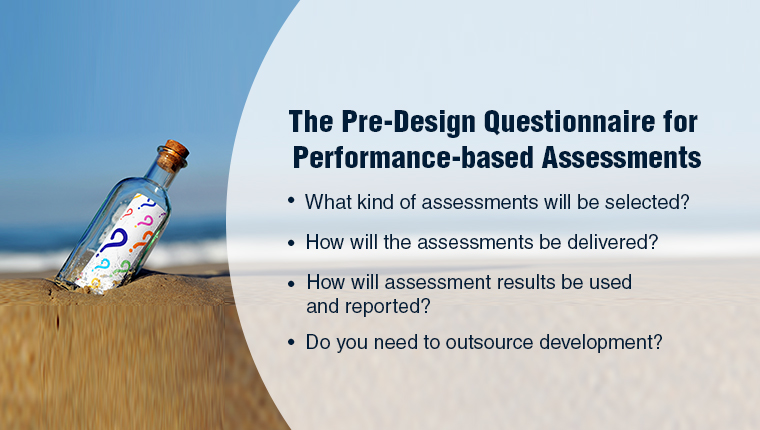3 Effective Formats for Performance-based Assessments: What’s Your Pick?

Unlike conventional assessments where learners are asked to recall information, performance-based assessments require learners to actually do something. This means learners have to actually perform a task to prove they have mastered the application of knowledge or skill being evaluated. For instance, an eLearning course on writing would require learners to write an article instead of answering multiple-choice questions about the structure of a paragraph or even grammar, for that matter.
Performance-based Assessments and Formats
Performance-based assessments require learners to perform tasks to demonstrate mastery of knowledge application.
3 Popular Formats of Performance-based Assessments
- Simulations
- Scenarios
- Role Plays
Performance-based Assessments
Put simply, performance-based assessments need to emulate the kind of tasks learners must perform in real-world contexts. For example, an eLearning course on safety training might require learners to demonstrate their understanding of the first steps to be taken in case of an accident. In this case, even a simple sequencing activity would suffice as a performance-based activity. On the other end of the spectrum, a simulation of the environment will also do.
It is imperative that the performance-based assessments are aligned to the learning objective(s). Consider the example of an eLearning course on how to use Adobe Premiere Pro. The two related learning objectives might be:
- Create a video using Adobe Premiere Pro
- Edit and update (modify) a video using Adobe Premiere
The action verbs here are Create and Modify which fall within the application level of Bloom’s Taxonomy for the Cognitive domain. Therefore, the performance-based assessment should require the learner to apply their knowledge (create or edit a video) to show their level of mastery. Setting clear learning objectives will help specify the exact performance to be assessed, along with the conditions and criteria for performance.
Let’s move on to the three formats for performance-based assessments.
Performance-based Assessments: 3 Potential Formats
1. Simulations
eLearning simulations are not only a great way to build practical knowledge through hands-on experience; they also provide an effective form of performance-based assessment. Learners are put in the “thick of things” where they have to perform tasks within a “mimicked” real-world situation.
This, in turn, allows you to evaluate how well your employees are putting their knowledge into practice while making decisions in simulated, true-to-life situations. Instead of evaluating your learners’ memorization skills, performance-based assessments using simulations let you check how they apply what they have learned in a real-world context.
For example, an organization wants to teach its HR managers how to input new employee information in their new Human Resource Information System (HRIS) software. The relevant learning objective could be:
Using the HRIS software, input new employee data
Again, the action verb “input” falls within the application level of Bloom’s Cognitive taxonomy. Hence, a simulation-based assessment should be used to evaluate whether learners are able to use the HRIS software (condition) to input new employee data. Learners are required to perform the procedure, instead of merely being assessed with fixed responses such as fill in the blanks, True/False, or matching.
2. Scenarios
Scenario-based assessments draw on the challenges your learners might face in the real-world. Learners are required to analyze information to reach appropriate conclusions and decide on appropriate action. It’s important that the scenarios depict realistic challenges so that learners relate to them and perform optimally.
Let’s look at an example to understand how scenarios can be used as performance-based assessments. An organization wants its employees to learn about the sales process followed in different branches of the organization across the globe. The relevant learning objective might be:
Compare the sales process followed in the UK with that of US
The action verb “compare” falls within the Evaluation level of Bloom’s taxonomy. In this level, a scenario-based assessment helps you assess learners’ ability to do the same. Learners could be given descriptions of how the needs of local customers were met (UK and US sales case examples) and then required to compare the two sales processes through a presentation or discussion.
3. Role Plays
In role playing activities, learners are required to act out various characters or roles in a given a scenario. How do you use them as performance-based assessments? Here’s an example: An energy organization wants its sales representatives to be able to recommend the best alternative among the three variants of their solar panels to customers. So, the relevant learning objective might be:
Given customer requirements, recommend the best alternative among the three solar panel variants
The action verb “recommend” comes within the Synthesis level in Bloom’s taxonomy. So, the assessment should be able to assess if learners can recommend the best alternative variant. To do so, you can opt for role playing that encourages learners to evaluate decisions from the customer’s perspective. Your learner can be a sales representative who is in a conversation with a customer looking to purchase solar panels. Keeping in mind their requirements, the learner can recommend the best one that suits the client’s requirements.
It’s Wrap Time!
Performance-based assessments are one way to validate that your learners have truly mastered the desired performance. It’s time to go beyond conventional assessments and make them authentic and carefully aligned with the objectives. While these are just three types of performance-based assessments you can choose from, the list is not complete. Would you like to add to it? Please feel free to share.




![4 Questions on Performance-based eLearning Assessments Answered! [Infographic]](https://blog.commlabindia.com/hubfs/Imported_Blog_Media/elearning-assessment-design-considerations-1.jpg)
